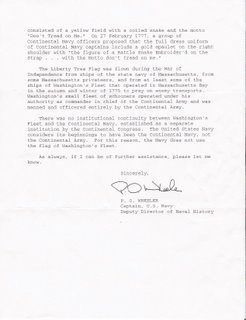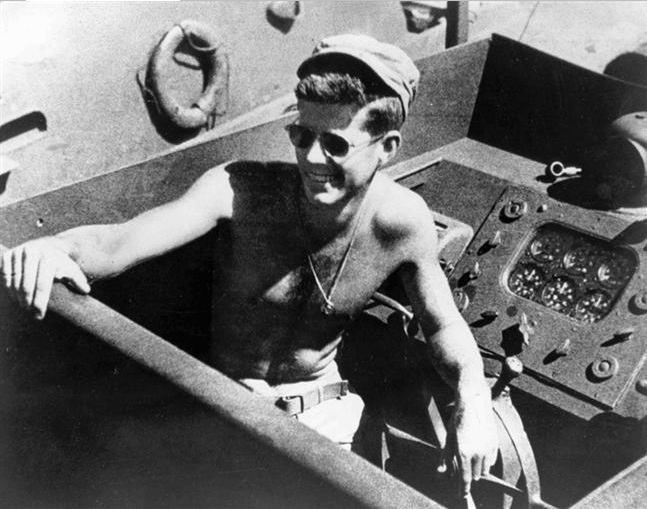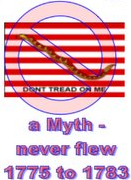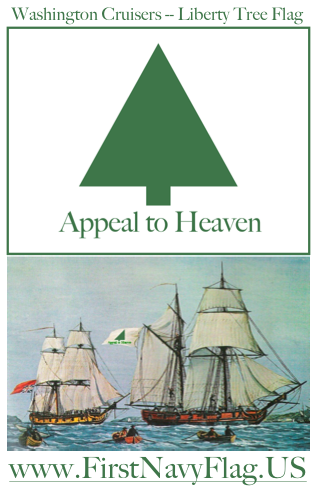

The first paragraph is a reasonable summary of this issue for the Navy to "substitute the Liberty Tree Flag in place of the Rattlesnake Jack". As to no plans for a substitute, when truth vs. fiction is clear to see, then serving Truth is an obligation.
The second paragraph provides interesting information that the Navy Birthday has only been observed since 1972, yet traces its birthday to the Continental Congress entry of 13 October 1775 shown in the Naval Documents of the American Revolution page 441 and 442, which shows the first action of that day was to read a letter from Commander in Chief George Washington that included discussion of Naval matters, and thereby made moot the committee debate as whether or not it would be too brash for this infant nation to establish a Navy to challenge, or even simply harass, the mightiest Navy in the world, the British Navy. So the birth of the Navy was measured from discussion of the Naval activities of General George Washington. Period. End of Story. (And yet other arguments will be presented.)
The third paragraph begins "The best historical information leads to the conclusion...". The way this is worded it could be considered true, or it could be considered false. There are just too many unclear allusions contained within the sentence. There is some historical information, but whether it is the best is questionable, that the thirteen alternating red and white stripes flag was flown on Continental Navy ships. True, there is some evidence that the flag as described, also called the Sons of Liberty Flag, may have flown, even likely flew on Continental Navy ships.
However, there is NO VALID HISTORICAL INFORMATION that the SNAKE OVER STRIPES FLAG EVER FLEW ON ANY CONTINENTAL NAVY SHIP. (Read the 52 page article by flag expert Peter Ansoff in the 2004 issue of the flag journal Raven, or read the one page summary elsewhere on this blog.)
The third paragraph as much as admits that the current Navy flag is false, a fabrication where it writes, "The modern addition of the rattlesnake and motto to the jack of the thirteen stripes creates a combination of three symbols with connections to the rich naval heritage of the American Revolution." Why combine symbols when a true flag with a rich naval heritage of the American Revolution already exists -- the evergreen Liberty Tree Flag?
But that sentence too is misleading. The "modern addition" derives from a false legend that began from Thomas Hart, an English artist, not known for his historical accuracy, in his fanciful portrait of the first Navy-only Commander in Chief, former Rhode Island Militia General Esek Hopkins, brother of Stephen Hopkins who was a member of the Continental Congress.
In the point paper elsewhere on this blog, details how the false Rattler flag legend was perpetuated by one well-meaning but historically poorly informed American after another, how one Navy Admiral Preble in 1872 at first believed the Snake flag legend and included it in his book on American flags, and then learned it was false and so tried in 1880 to correct his previous error, and mentions how the snake on its belly may have been intended as an insult of the American Navy.
In another portrait by Hart, of Colonel Benedict Arnold outside of Montreal, Hart paints a palm tree in the background, a flora not found so far north. So much for Hart's reputation for historical accuracy.
And as far as the Rattlesnake as a symbol of the English colonies about the time of the Seven Years Wars 1756-1763 (the European moniker, typically called the French and Indian War in America 1754-1763) the statement is true enough, but the evergreen tree is a symbol of the English colonies back into the 1600's.
The Sons of Liberty met under the Tree of Liberty in Boston, that was cut down by British Loyalists in mid-August 1775, weeks before the Liberty Tree Flag flew on 2 September 1775 as the First Navy Flag on the first Continental Navy ship, the Hannah, and then at least six others Continental Navy ships. As such, it was a direct statement of resistance to tyranny, and an independent spirit unmatched by any other early flag, or later fabricated flag.
The fourth paragraph states "In early 1776 Commodore Esek Hopkins, the first and only commander in chief of the Continental Navy fleet, used a personal standard designed by Christopher Gadsden of South Carolina. This flag consisted of a yellow field with a coiled snake and the motto "Don't Tread on Me." Whether this is true or not is subject to question among careful flag historians.
It is true there was the Gadsden flag as described. When and whether the Gadsden flag was flown by General, or Commodore, Esek Hopkins after he was named to head the Navy fleet out of Philadelphia is not clearly established.
Further, there are several historical sources that indicate that Captain John Manley was named as the Commodore of the Continental Navy ships operating in the "Northern Fleet" (NOT Massachusett State Navy.)
On the second page of the CNO letter by CAPT Wheeler, a very interesting bit of history is provided that in fact proves the point AGAINST THE NAVY SNAKE FLAG. It tells how barely a year after the personal standard of the snake flag MAY have been flown, that a group of Continental Navy officers proposed a dress uniform epaulet with "the figure of a Rattle Snake Embroider'd on the Strap... with the Motto don't tread on me." The letter does NOT say such a proposal was adopted, and so if not, it could be reasonably presumed the unwise proposal was rejected by "wiser heads" in higher authority.
The fifth paragraph on page 2 is the most misleading by its presentation of erroneous information. Elsewhere on this blog are graphic presentations of how several parts of this paragraph are not correct. First the Liberty Tree Flag first flew on Continental Navy ships commissioned by Commander in Chief of all Continental forces, George Washington beginning on 2 September 1775. The Massachusetts Navy flag adopted that flag as its own on 26 July 1776.
The statement "ships of Washington's Fleet that operated in Massachusetts Bay..." is just incorrect. The powerful British Navy was anchored in the Massachusetts Bay so the Continental Navy ships would have been foolhardy to operate there. The plan as stated in Washington's original orders to the first Continental Navy ship Captain Nicholas Broughton was to "operate on the High Seas..." to capture inbound British merchant unarmed or lightly armed supply ships and take them to ports near Boston by free from British control.
Those captures of supply ships had a dual military purpose - one to deny supplies to the enemy, and two to provide much needed arms, ammunition, clothing, and food for the Continental Army from the captured British supply ships.
The Continental Navy ships commissioned by Washington, and confirmed by the Continental Congress committee, were similar to the "skirmishing" on land by the cavalry by such military leaders as Major (later General) Light Horse Harry Lee, where the plan was to hit and retreat, to capture supply wagons, and avoid a military fight, all part of a siege campaign, and like the American Indian warfare technique of ambush.
The next part of that fifth paragraph that is misleading is the statement, "...was manned and officered entirely by the Continental Army." Again a graphic rebuttal of this is presented elsewhere on this blog. Quotes from the 1960 book George Washington's Navy by William Bell Clark, who also served as an editor of the Naval Documents of the American Revolution that the Navy uses to establish the Navy Birthday as 13 October, disprove this statement.
Further, a letter found at the University of Virginia George Washington Papers Project from the Commander in Chief (of all Continental forces) to his subordinate General, now Commodore, Esek Hopkins to please return the 200 soldiers lent by Washington to Hopkins to man the Navy's ships, tends to make this argument moot.
The sixth paragraph continues with another incorrect statement, "There is no institutional continuity between Washington's Fleet and the Continental Navy, established as a separate institution by the Continental Congress." This is wrong from a number of different perspectives. One as discussed above, the Congressional debate on whether to start a Navy ended when the Navy committee learned that Washington had already established a Navy and captured British ships. Two, the Navy committee traveled to Boston by 22 October 1775 to review the plans of Washington to establish the fleet of Continental Navy ships, and approved the plans, even to the extent of many of the ships being named for leaders of the Continental Congress. Three, later John Hancock, president of Continental Congress named a man to serve as the Continental agent to replace the agents originally appointed by Washington, to receive and process the captured ships of the Continental Navy ships commissioned by Washington.
In the sixth, and next to last paragraph, the concluding sentences are accurate in stating the current situation that reflects the "institutional attitude" reflected by the quasi-humorous saying, "Don't confuse me with the facts, my mind is made up." The words written are "The United States Navy considers...", or rather continues holding onto the false Snake flag.
The next part is written, "... its beginnings to have been the Continental Navy, not the Continental Army." which is a rationalization not based on the facts. The first Navy Commodore had served as an artillery General in the Rhode Island Militia, and likely was named in part due to his influential brother Stephen Hopkins, who served in the Continental Congress.
This letter fails to tell the "rest of the story" that from the very first, this Navy Commander in Chief, Commodore Esek Hopkins, failed to carry out the orders as originally written, and later was "fired" from his position. On the other hand, the first Navy ship Hannah commissioned by Commander in Chief George Washington had a ship's captain Nicholas Broughton who failed to carry out his orders as written.
Both sets of ships, those of Washington and those of Hopkins were manned in part by volunteers from the Continental Army, and certainly volunteers from state militiamen like those of Rhode Island where General Esek Hopkins had served before being appointed to head the fledgling Navy founded by Washington.
The Liberty Tree Flag, also called the Washington Cruisers Flag, is clearly the true First Navy Flag by several months over any other "challenger". For this reason, the statement "For this reason, the Navy does not use the flag of Washington's fleet." is not consistent with the facts of history that call for this flag be substituted for the fictional "retreating Rattler" Snake flag.
The last paragraph, the seventh, concludes the letter with the words, "As always, if I can be of further assistance, please let me know." Late in the day on Friday, 17 February 2006, days before the Monday federal Washington Birthday Holiday, I called and left a message for Captain P. O. Wheeler at the number I received for him at 202-433-8271.
The assistance I ask is for the Navy to have the courage to serve the truth, the true facts of Navy history, and the openly acknowledge the facts that the First Continental Navy ships flew the "Washington Cruiser" flag, or the Liberty Tree Flag, that honestly acknowledges what numerous Navy historians have said that the Continental Navy was created by Commander in Chief George Washington, who had an appreciation of the importance of a Navy from his older brother's experience with Admiral Edwin Vernon, for whom Mount Vernon was named, during the campaign in Columbia, South America against the Spanish, in the War of Jenkin's Ear.
The best action for the Navy would be to adopt the Liberty Tree flag as the Navy Jack during the Global War for Liberty Over Terrorism.
Saturday, January 28, 2006
Detailed Reply to CNO letter of 23 Jan 2006 by CAPT P.O. Wheeler, USN
Posted by
"George Washington" 'States'Manship
at
Saturday, January 28, 2006
![]()
![]()
Subscribe to:
Post Comments (Atom)










No comments:
Post a Comment